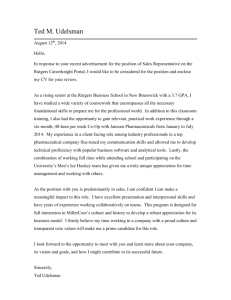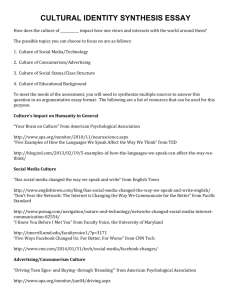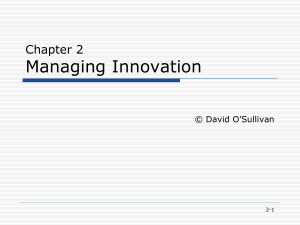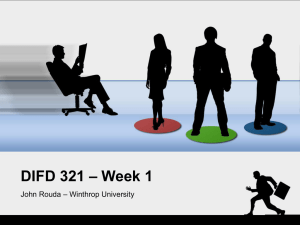12 T Responding to the Mental Health Needs of Students
advertisement
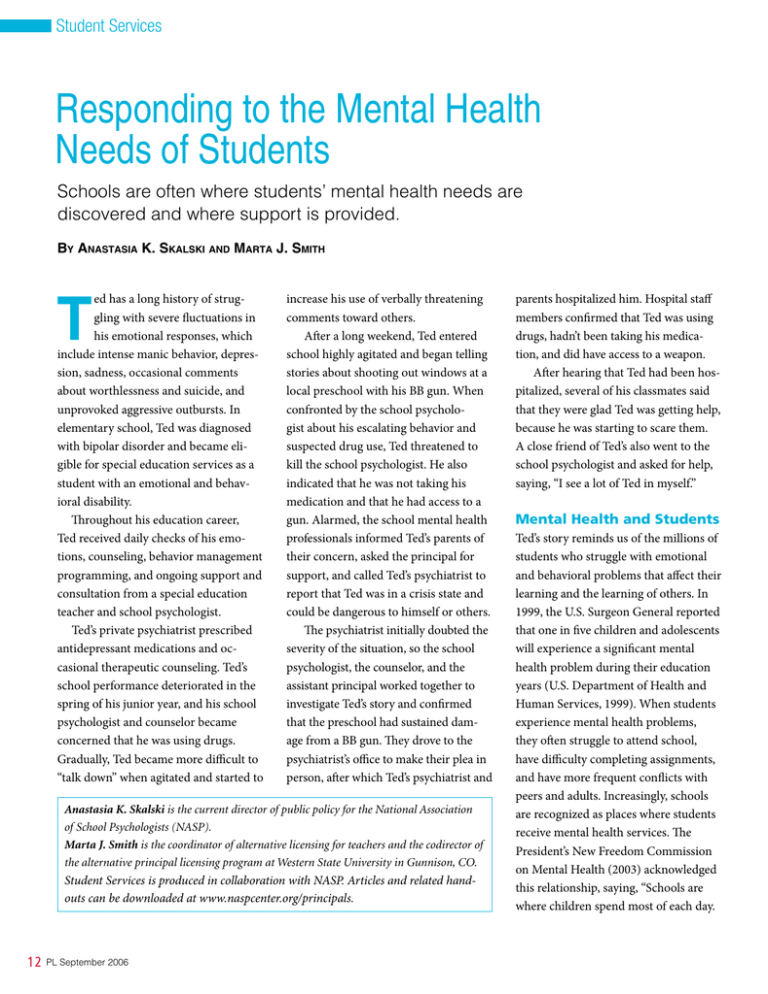
Student Services Responding to the Mental Health Needs of Students Schools are often where students’ mental health needs are discovered and where support is provided. By Anastasia K. Skalski and Marta J. Smith T ed has a long history of struggling with severe fluctuations in his emotional responses, which include intense manic behavior, depression, sadness, occasional comments about worthlessness and suicide, and unprovoked aggressive outbursts. In elementary school, Ted was diagnosed with bipolar disorder and became eligible for special education services as a student with an emotional and behavioral disability. Throughout his education career, Ted received daily checks of his emotions, counseling, behavior management programming, and ongoing support and consultation from a special education teacher and school psychologist. Ted’s private psychiatrist prescribed antidepressant medications and occasional therapeutic counseling. Ted’s school performance deteriorated in the spring of his junior year, and his school psychologist and counselor became concerned that he was using drugs. Gradually, Ted became more difficult to “talk down” when agitated and started to increase his use of verbally threatening comments toward others. After a long weekend, Ted entered school highly agitated and began telling stories about shooting out windows at a local preschool with his BB gun. When confronted by the school psychologist about his escalating behavior and suspected drug use, Ted threatened to kill the school psychologist. He also indicated that he was not taking his medication and that he had access to a gun. Alarmed, the school mental health professionals informed Ted’s parents of their concern, asked the principal for support, and called Ted’s psychiatrist to report that Ted was in a crisis state and could be dangerous to himself or others. The psychiatrist initially doubted the severity of the situation, so the school psychologist, the counselor, and the assistant principal worked together to investigate Ted’s story and confirmed that the preschool had sustained damage from a BB gun. They drove to the psychiatrist’s office to make their plea in person, after which Ted’s psychiatrist and Anastasia K. Skalski is the current director of public policy for the National Association of School Psychologists (NASP). Marta J. Smith is the coordinator of alternative licensing for teachers and the codirector of the alternative principal licensing program at Western State University in Gunnison, CO. Student Services is produced in collaboration with NASP. Articles and related handouts can be downloaded at www.naspcenter.org/principals. 12 PL September 2006 parents hospitalized him. Hospital staff members confirmed that Ted was using drugs, hadn’t been taking his medication, and did have access to a weapon. After hearing that Ted had been hospitalized, several of his classmates said that they were glad Ted was getting help, because he was starting to scare them. A close friend of Ted’s also went to the school psychologist and asked for help, saying, “I see a lot of Ted in myself.” Mental Health and Students Ted’s story reminds us of the millions of students who struggle with emotional and behavioral problems that affect their learning and the learning of others. In 1999, the U.S. Surgeon General reported that one in five children and adolescents will experience a significant mental health problem during their education years (U.S. Department of Health and Human Services, 1999). When students experience mental health problems, they often struggle to attend school, have difficulty completing assignments, and have more frequent conflicts with peers and adults. Increasingly, schools are recognized as places where students receive mental health services. The President’s New Freedom Commission on Mental Health (2003) acknowledged this relationship, saying, “Schools are where children spend most of each day. While schools are primarily concerned with education, mental health is essential to learning as well as to social and emotional development. Because of this important interplay between emotional health and school success, schools must be partners in the mental health care of our children” (p. 58). What Is Mental Health? Mental health, like physical health, may be viewed as existing on a continuum from healthy living to chronic illness. In 2001, the U.S. Surgeon General defined mental health as “the successful performance of mental function, resulting in productive activities, fulfilling relationships with other people, and the ability to adapt to change and to cope with adversity” (U.S. Department of Health and Human Services, 2001). A person with positive mental health uses interpersonal assets and skills to function successfully in his or her daily life. Mental health problems emerge when these assets and skills begin to deteriorate, resulting in a struggle to cope with life’s challenges and responsibilities. The continued deterioration of these skills signals the onset of mental illness as significant distortions to thinking, coping, and responding dominate personal functioning and impair a person’s ability to perform the activities of daily life. All people fall somewhere on this continuum on any given day. Why Is It Important? The specific mission and purpose of school has long been debated; however, there is general agreement that schools should promote learning for the purpose of creating productive citizens. In the era of the No Child Left Behind Act, schools are held accountable for academic learning through student performance assessments. Research demonstrates that students with good mental health are more successful in school. A recent longitudinal study provided strong evidence that interventions that strengthened students’ social, emotional, and decision-making skills also positively affected their academic achievement in terms of higher standardized test scores and better grades (Fleming et al., 2005). Research also demonstrated that there is a societal benefit to investing in the positive mental health of students. For example, it is known that students who are struggling emotionally and behaviorally are more likely to drop out of school. A study by the Teacher’s College at Columbia University (2005) estimated that the United States loses $192 billion (1.6% of the gross domestic product) in combined income and tax revenue with each cohort of students who fail to complete high school. Recommendations Responding to the need for comprehensive, coordinated mental health services begins with strong leadership. Principals and central school administrators should publicly acknowledge and promote school climates that support positive mental health and take steps to demonstrate support. Step 1: Build the capacity of staff members to respond to the mental health needs of students. Building capacity begins with being aware of and providing the professional development and training needed to help staff members respond to student needs. It is important that all staff members (including teachers, bus drivers, and paraprofessionals) be able to interact positively with all students, including those with severe emotional and behavioral needs. Principals must ask specific questions, such as, Are staff members familiar with the early warning signs of emotional and behavioral health problems? Do staff members know how to respond when students share sensitive personal information? Do staff members know who the mental health professionals in their building are and how they can help students? Do the policies and procedures of the school help teachers and students respond to mental health needs, including those that reach crisis proportions? Step 2: Hire adequate numbers of school mental health professionals and empower them to take leadership roles in the provision of mental health services in the school. The National Association of School Psychologists, the American School Counselor Association, and the School Social Work Association of America all have recommended ratios for the maximum number of students to each professional. The average ratio in the United States is currently 2–3 times greater than the maximum levels recommended by each of these groups, which are 250 students per counselor, 400 per social worker, and 1,000 per psychologist (American Counseling Association et al., 2006). These poor staffing ratios compromise the ability of professionals to sufficiently address the mental health needs of students. Although schools often have access to the expertise of both school-based and community-based mental health providers, it is important that schoolemployed professionals be empowered to have an integral leadership role in PL September 2006 13 Student Services providing mental health services in the school setting. Certainly, both sets of professionals are capable of assessing and responding to the mental health needs of students, and communityemployed providers can be a valuable resource. Only school mental health professionals, however, are required to have specific training in school systems, educational learning theories, school law, and intervention and prevention in school environments. It is imperative that school administrators and schoolbased mental health professionals work collaboratively to support students. When community-based professionals provide services in schools, they should coordinate closely with their school counterparts. Step 3: Promote a continuum of services that includes schoolwide mental health prevention programming and intensive interventions. Research demonstrates that students in schools that use schoolwide positive behavior interventions and supports show reduced problem behaviors (High Desert Education, 2005), improved social skills (Anderson & Kincaid, 2005), and improved academic performance (Nelson, Martella, & Marchand-Martella, 2002). Prevention programs that reach all students and target students at risk for failure are crucial to any school mental health program. Examples of these universal prevention programs include school violence prevention, bullying prevention, social skills training, developmental asset building, conflict resolution, and social norming campaigns. School psychologists, counselors, and social workers also routinely support students with severe needs and identified mental health conditions, including students who receive support from special 14 PL September 2006 education. These services include direct interventions, such as counseling and behavior planning and support, as well as consultative and transitional services for families, teachers, and community providers. When the severity and intensity of student needs exceed the capacity of the school staff, schools must partner with community professionals to adequately meet student needs. The UCLA Center for Mental Health in the Schools suggests that policymakers and school staff members work together with community providers and families to build integrated interventions and supports that will meet student needs no matter where they fall on the mental health continuum (Adelman & Taylor, 2006). Step 4: Create opportunities to regularly assess the mental health needs of students and the effectiveness of school-based services. Assessing the mental health needs of students involves both informal and formal methods. Informal approaches can be as simple as checking in with students of concern daily, observing and listening to student interactions in the lunchroom and hallways to determine how people are doing, or setting aside a specific time in weekly leadership meetings to discuss student needs and issues. It is also important for schools to consider formal methods that are designed to measure mental health. Collecting data that examine school climate Mental Health Resources for Schools Several federal agencies have teamed up to support school-based mental health programs through grant funding. Although there are too many school district requests for available funds to fulfill, federal grants enable schools to respond to student needs by providing money for comprehensive programs. Examples of federal grant programs include the Elementary and Secondary School Counseling Program (ESSCP) and Safe Schools, Healthy Students. ESSCP is supported by the U.S. Department of Education (ED). The program seeks to establish and expand school-based counseling programs and makes funds available to hire school mental health professionals. ESSCP received $34.6 million in FY 2006. It is important to note that all of this money currently goes to elementary school prevention programming: funding must reach at least $40 million before funds may be used for secondary school programming. The Safe Schools, Healthy Students initiative is collaboratively funded by ED, the U.S. Department of Justice, and the Substance Abuse and Mental Health Services Administration (SAMHSA). The initiative seeks to build safe school environments through stronger school safety policies and practices, prevention interventions, early childhood initiatives, and educational reform. In addition, SAMHSA and the Human Resources Services Association fund two technical assistance centers that support school improvement efforts associated with mental health. The UCLA Center for Mental Health in Schools (http://smhp .psych.ucla.edu) and the Center for School Mental Health Analysis and Action (http://csmha.umaryland.edu) offer resources, materials, research articles, and policy guidance for school leaders working to build comprehensive school mental health programs. Resources on the Web Office of Safe and Drug Free Schools: Materials for School Leaders www.ed.gov/admins/lead/safety/edpicks.jhtml?src=qc Helping America’s Youth: Specific Program Recommendations www.helpingamericasyouth.gov/programtool-ap.cfm SAMHSA Child and Adolescent Mental Health Information www.mentalhealth.samhsa.gov/child/childhealth.asp Youth Violence Prevention: Safe Schools, Healthy Students Program www.sshs.samhsa.gov OSEP Technical Assistance Center’s Positive Behavior Interventions and Supports www.pbis.org/main.htm Social Norming Resources www.socialnorm.org Developmental Asset Building www.search-institute.org/assets What Works Clearinghouse www.whatworks.ed.gov Promising Practices Network www.promisingpractices.net Center for Effective Collaboration and Practice http://cecp.air.org Center for School Mental Health Analysis and Action http://csmha.umaryland.edu Youth Risk Behavior Survey www.cdc.gov/HealthyYouth/yrbs/pdf/questionnaire/2005highschoolquestionnaire.pdf variables (such as class participation and attendance; the frequency, intensity, and duration of misconduct; and ongoing progress monitoring conducted as part of a response to intervention process) is a necessary activity for any school. Voluntary screening for depression or other mental health problems also can be a useful way to assess student needs. Schools may also want to query student beliefs and behaviors through formal surveys (such as the Youth Risk Behavior survey), observational data, or student satisfaction data. Principals should work closely with school mental health providers to ensure that data is regularly collected and to examine the extent to which services were available, were accessed by students and adults, and effectively promoted positive mental health in students. pals who genuinely care about the welfare of everyone who enters their buildings will experience success when faced with inevitable emotional issues and crises if they are well-informed and prepared to respond with the best interests of students and staff members at heart. Effective principals listen to the pulse of their school, pay attention to the things that do not “feel right,” and build the capacity of staff members to react to specific situations in a calm, caring manner. PL standardized test scores and grades? Journal of School Health, 75, 342–349. n High Desert Education. (2005). New Mexico Positive Behavior Support: Annual report, 2004–2005. Albuquerque, NM: Author. Retrieved June 5, 2006, from the New Mexico Positive Behavior Support Web site: www. nmpbs.org/annual%20report/PBS_report _2004_05.pdf n Nelson, J., Martella, R., & MarchandMartella, N. (2002). Maximizing student learning: The effects of a comprehensive school-based program for preventing problem behaviors. References Journal of Emotional and Behavior Disorders, 10, n Adelman, H., & Taylor, L. (2006). The current 136–148. status of mental health in the schools: A policy n President’s New Freedom Commission on and practice brief. Los Angeles: UCLA School Mental Health. (2003). Achieving the promise: Mental Health Project. Transforming mental health care in America. n American Counseling Association, American Final report (DHHS Pub. No. SMA-03-3832). School Counseling Association, National As- Rockville, MD: Department of Health and sociation of School Psychologists, & School Social Human Services. Work Association of America. (2006). Removing n Teachers College, Columbia University. Conclusion barriers and improving student outcomes: The (November, 2005). The social costs of inadequate Principals are responsible for promoting a caring school community that includes high expectations and support resources for students and staff members who are struggling to cope with the demands of daily life. Caring school communities emphasize the need to reach and teach the whole child (i.e., academic, behavioral, and social-emotional facets) within their whole environment (i.e., the school, the family, and the community). Princi- importance of school-based mental health services. education. Symposium conducted at Columbia http://www.nasponline.org/advocacy University, NY. /briefinghandout0306.pdf n U.S. Department of Health and Human n Anderson, C., & Kincaid, D. (2005). Applying Services. (1999). Mental health: A report of the behavior analysis to school violence and disci- surgeon general. Executive summary. Rockville, pline problems: School wide positive behavior MD: National Institute of Mental Health. support. Behavior Analyst, 28, 49–63. n U.S. Department of Health and Human n Fleming, C. B., Haggerty, K. P., Catalano, R. Services. (2001). Mental health: Culture, race, F., Harachi, T. W., Mazza, J. J., & Gruman, D. H. and ethnicity—A supplement to mental health: (2005). Do social and behavioral characteristics A report of the surgeon general. Rockville, MD: targeted by preventive interventions predict Author. PL September 2006 15


